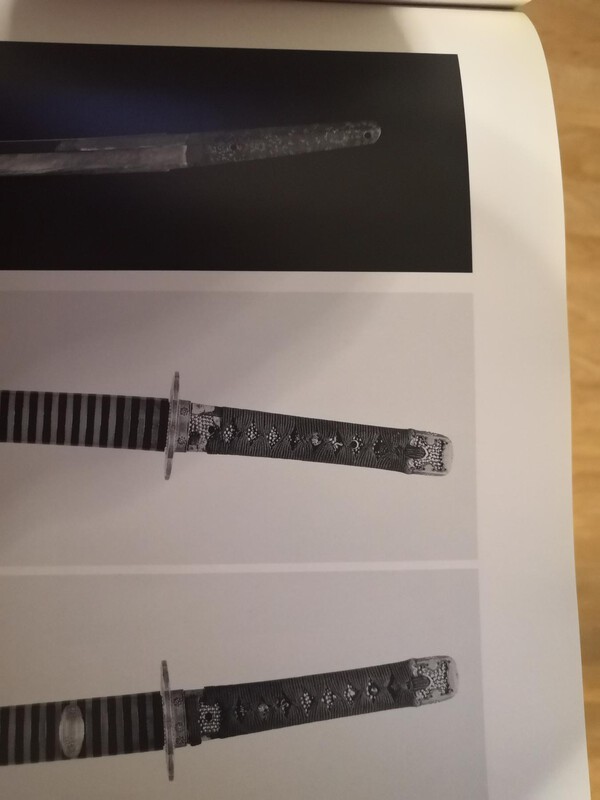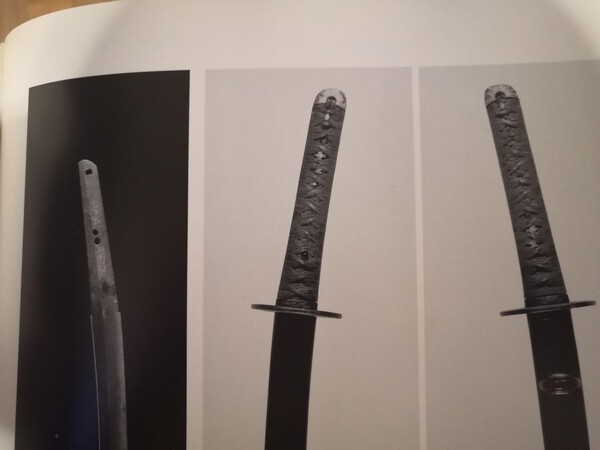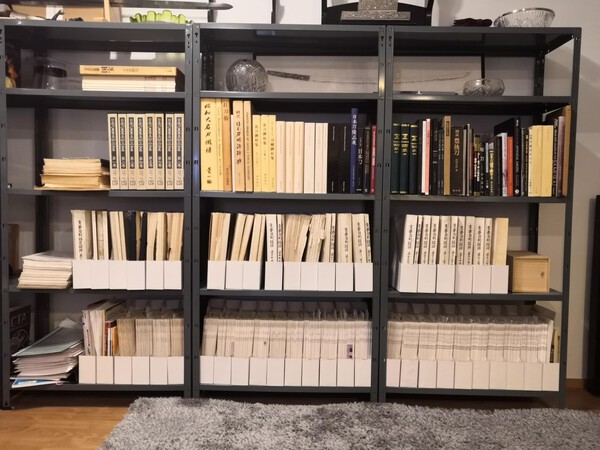-
Posts
2,142 -
Joined
-
Last visited
-
Days Won
37
Content Type
Profiles
Forums
Events
Store
Downloads
Gallery
Everything posted by Jussi Ekholm
-

Jūyō & TJ pass rates
Jussi Ekholm replied to Jussi Ekholm's topic in General Nihonto Related Discussion
Unfortunately in the results NBTHK just has two general categories so you will have to manually pick the Shinshinto from the items. Session 65 only one passing was a katana by Sa Yukihide. Session 64, daisho by Suishinshi Masahide, katana by Taikei Naotane, katana by Koyama Munetsugu, katana by Minamoto Masayuki (Kiyomaro) and 3x katana by Kurihara Nobuhide. Session 63, katana by Ozaki Suketaka, katana and wakizashi by Taikei Naotane, katana by Hosokawa Masamori, katana by Koyama Munetsugu, katana & naginata by Kurihara Nobuhide, katana by Sa Yukihide, katana by most likely 3rd gen Satsuma Masayoshi going by date, katana by Ason Masayuki. Session 62 katana by Taikei Naotane, 2x katana by Sa Yukihide Session 61, wakizashi by Gassan Sadakazu (1906), katana by Suishinshi Masahide, katana by Taikei Naotane, daisho by Koyama Munetsugu, 2x katana by Sokan, katana by Unju Korekazu, katana by Kurihara Nobuhide, 2x katana by Sa Yukihide, katana by Nagasada, katana by Motohira and katana by Ason Masayuki. Session 60, katana by Gassan Sadakazu (1906), 2x katana by Taikei Naotane, 2x katana by Koyama Munetsugu, katana by Sokan Now that is just few latest results but those names keep popping up mostly when it comes to Shinshinto at Juyo. However I need to point out that Gassan Sadakazu seems to be upcoming, before those two I think there was only one passing in session 20. I am not too well versed in Shinshnto but it is these big names that pop up at Juyo level and maybe occasionally a sword by lesser known smith passes. -
Koshirae is not really my strong point but as I do happen to own a good selection of books, here are two original koshirae (and their blades) from Uchigatana Koshirae book. Number 63 (that gets turned sideways) - Sword made by Kiyomitsu in 1514, koshirae can be dated somewhere around Kanbun - Genroku (1661 - 1704) Number 48 - This is the first and original one (second similar one to this featured in book was copied for Heshigiri Hasebe in early 1800's) - Sword made by Sukesada in 1524, koshirae can be dated to be made between 1598 to 1604.
-

Jūyō & TJ pass rates
Jussi Ekholm replied to Jussi Ekholm's topic in General Nihonto Related Discussion
As I was answering to another topic I remembered I had made this one too, so I can maybe update session 65 stats in here Swords - 1003 submissions - 101 passes (97 Kotō - 4 Shintō) Koshirae - 45 submissions - 8 passes Tosogu - 293 submissions - 29 passes In total - 1341 submissions - 138 passes As there was discussion about this being a tight session, the numbers say it so too. One of the lowest pass rates in the last 20 sessions. Of course unfortunately we dont have access to all the items sent to this shinsa but it seems to be really tough on later swords with only 4 passing... -

Sword numbers/stats
Jussi Ekholm replied to bigjohnshea's topic in General Nihonto Related Discussion
I tried to calculate the estimated number of Hozon & Tokubetsu Hozon swords by their numbering logic some time ago. Darcy dropped some actual facts in there as number for Jūyō and Tokujū. http://www.militaria.co.za/nmb/topic/26496-nbthk-paper-numbering/ To continue on that above thread, I have Hozon 390646 saved so that would indicate at least 90,646 swords passed Hozon before they upgraded, then I have 3000026 so it was in first shinsa after changing numbering. Most recent paper I have saved is 3021948 from last year. Based on that logic at least 110,000+ swords have passed Hozon. Similarily for Tokubetsu Hozon I have 155697 saved, so at least 55,697 swords passed Tokubetsu Hozon before upgrade. Then I have 1000059 so it was in first shinsa after change. Most recent Tokubetsu Hozon I have saved is 1011475 from last year. Based on that logic I used in the thread at least 66,000+ swords have passed Tokubetsu Hozon. Then you can take the real factual numbers Darcy provided and maybe round them up a bit. So the list would be something like this (of course changing with sessions coming up). Hozon - 110,000 swords TH - 65,000 swords Jūyō - 11,500 swords TJ - 1,100 swords Well actually as the sword passes on to higher tier it is removed from earlier pool but the basic logic should give some idea about how many have passed in which level for NBTHK. Then there are of course interesting things to consider as what is passing high tier shinsa and when it is passing. I did a post on submissions in here http://www.militaria.co.za/nmb/topic/28933-j%C5%ABy%C5%8D-tj-pass-rates/ -

Keith Larman passing
Jussi Ekholm replied to PNSSHOGUN's topic in General Nihonto Related Discussion
My condolences to friends and family. I will remember how much he helped many new guys in this hobby. -

Favorite Era for Sword Making
Jussi Ekholm replied to Blazeaglory's topic in General Nihonto Related Discussion
I am bit torn two ways. I find myself looking after the "stereotypical" Enbun-Jōji sugata (well not necessarily from that actual time frame but the massive grand shape) and on the contrary I am also liking slender and very curved tachi shape. For me it is the shape before anything else. Well of course in ideal world I could match great quality with the shape but need to stay in reality... -

Show off your Nihonto book collection
Jussi Ekholm replied to bigjohnshea's topic in General Nihonto Related Discussion
As there was a post about visiting collectors, there are so many book titles in these collections that I would love to browse. -
I think Tom has it correct - 清宮 Kiyomiya
-
相模守政常 - Sagami no Kami Masatsune
-
The Tsukamaki book by Thomas Buck has many styles and instructions to do them. It is very nice book and I'd recommend getting one if you are interested. I sold mine a while ago but it was nice to have it. I believe these are the tsukamaki style sheets that Ian mentioned earlier. TsukamakiStyles Part1.pdf TsukamakiStyles Part2.pdf
-

Show off your Nihonto book collection
Jussi Ekholm replied to bigjohnshea's topic in General Nihonto Related Discussion
Here is mine, I've been focusing on books for the last few years maybe even over swords. I just feel like I can't usually afford the swords I would like for a good while and on the other hand I can get super interesting books that bring me joy. I've been trying to focus my book collecting too, and I am trying to be more picky on what I will get in future. There are just so many interesting books out there that I would love to have.- 41 replies
-
- 11
-

-
I think it can be sometimes really difficult to date the swords ESPECIALLY for us beginner and bit advanced collectors, and even some Japanese experts have voiced that fact. I remember for example Hinohara Dai stating some small differences in NBTHK magazine articles that many beginning and advanced collectors often fail to notice. And it will take very experienced eye and knowledge to immidiately catch them. When working with loads of items and time restrictions you can of course miss some things even if you are an expert. I am not going to debate between organizations, as each of them have shinsa panel with knowledge far exceeding mine. However I must note that the problem I see in overseas shinsa are the circumstances. I must admit I do not know how shinsa panel makes the judgements and calls and what references they use but I would think if they are doing it in their "home base" they have all the possible references they have in use (for example NBTHK has a record of all items passed previously). When you are doing overseas shinsa I do believe they are more limited on resources. As I stated on the previous thread about this sword I have never seen similar mei reference anywhere. NTHK seems to have or they otherwise agree on it as they papered it. Granted I don't focus my interest on swords of this era but I do have quite many reference mei now in general from earlier times. Of course Dōtanuki works are quite rare but some can be found easily online. 九州肥後同田貫上野介 is by far the most common signature among this school. Here are some examples https://www.seiyudo.com/ka-010118.htm https://iidakoendo.com/2592/ https://tokka.biz/sword/dotanuki.html http://www.nipponto.co.jp/swords3/KT324342.htm https://www.touken-matsumoto.jp/eng/product_details_e.php?prod_no=WA-0333 Here you can see Munehiro dated 1847 with small write up: https://nihontou.jp/choice03/toukenkobugu/tachi/061/00.html I was surprised to find out there was an article at Ohmuras site about the school: http://ohmura-study.net/040.html
-

Wife didn't know what to get me for Xmas
Jussi Ekholm replied to bigjohnshea's topic in Auctions and Online Sales or Sellers
Very nice catch. The second scroll is oshigata of Jūyō Bijutsuhin sword by Masatsune. -
Seems like the issuing body for papers is 美術日本刀保存会 - Bijutsu Nihontō Hozon Kai. Unfortunately I have never heard about them before, seems like it was issued in Janurary 2019. I think I might have seen a paper or two issued by them at Japanese auction sites before but I've skipped them. With google I managed to find they probably are located in Okayama: https://www.hotfrog.jp/company/1123282600243200 I think the seller left out lot of information saying to you and that seems to be quite common with most sellers. He should have been able to tell you that Tadamitsu was dated as Steve translated to you, and that Masaie is attributed to Bingo province and not Bizen. There were many Masaie smiths in Mihara school and Muromachi period smith could be very likely. Also the fact that both blades fall under the modern wakizashi classification, which will affect the price, as well as the fact that they were most likely quite recently put together in matching koshirae. The sellers in Japan know well what they are doing and what will attract buyers. I hope you don't find this comment too negative as that was not my intention. I do believe you have 2 genuine Japanese swords from the late Muromachi period as is listed in the paper. Even though the issuing body does not hold commercial value their attribution seems to be most plausible one given one is signed and dated and other signed. If signatures are legitimate I'd guess other organizations would give the same answer.
-

Dojigiri
Jussi Ekholm replied to Bugyotsuji's topic in Sword Shows, Events, Community News and Legislation Issues
So far I have got 23 signed tachi by Ko-Hōki Yasutsuna, 1 fumei tachi and 4 mumei katana attributed to him The second sword that Andi is asking about is owned by NBTHK and it is very often featured in Tōken Bijutsu and other publications too. So far I have it on 11 references. I think the most commonly listed length for it is 80,1 cm (even though it is 79,9 cm in your pic, there can very often be few mm differences between publications). It has 2,9 cm sori, 2,8 cm motohaba, 1,7 cm sakihaba and 20,9 cm nakago. -

Would appreciate any help identifying the maker and rarity
Jussi Ekholm replied to Rmueller9's topic in Nihonto
Posted this few days ago on another forum. Signature is 以安来鋼兼道作, smith is Kojima Kanemichi. Date is: 紀元二千六百年 Kigen nisen roppyaku nen = 2600 Imperial year which means 1940. There are plenty of folks here specializing on this period so you'll get more info. You can also google the signature and find other examples. -
Thanks for posting the link Wim. Interesting results and items passed this time too. I just wish I could study all of them.
-
Very interesting thread Ed, and I am bit surprised about the result. Even though I don't know much about swords of this time I didn't think all were papered and legitimate (apart from 7 which I think might be better signature wise than some of the papered ones). Was a fun guessing and made me look at stuff I might skip on normally.
-
I'll give an answer like a politician. As I don't focus on swords of this period, I have bit limited resources of reference material on Masahide, at least that I can quickly access. However on the reference material I have there are examples that are very close / quite close to numbers 5,6,8, for the other examples I haven't got a reference mei that would be close to it. So I am left guessing on others.
-
Like Jean mentioned earlier I think 5 & 8 are of same sword and legitimate, I also think number 6 is legitimate too. I found lots of mei similar to 5 & 8 spanning from 1789 to 1815, published examples, and I think examples of mei 6 seems to be made around 1789 to 1796.
-
For me it is thinking about the romantic history behind them. My own interest in Japanese swords mostly spans from Heian until mid-Muromachi. Bit similarily my interest in European swords mostly spans from Migration period until end of Renaissance. Can't really explain why shortly but I just think for example viking age is interesting as is the Nanbokuchō period and so on. Just the time and history that is fascinating to me. Unfortunately I don't think there is too much researched data in English about steel analysis regarding regional changes in Japanese history. We have had few threads about it over the years, here is one: http://www.militaria.co.za/nmb/topic/23184-steel-analysis-of-different-regional-schools/ As I know I cannot afford the fine quality top tier old swords and partly because living here up north, I've been really fascinated about bit lesser known rural schools. Some time ago I also encountered an article by Yoshikawa Kentaro about swords in Northern Japan and it had greatly informative bit where he mentioned that somewhat rough hada "hadatatsu" "hadamono" that often is prominent in swords of Northern region actually improves the performance in cold climate and hadamono swords offer good flexibility and strength. Living here in cold north myself I find stuff like this really fascinating. I don't consider myself as an art connoisseur who goes after top quality (as it is way beyond my means) but kinda low/mid tier collector going after what I consider to be interesting items. Hōju or Gassan tachi from up north would be right up my alley where as most of the serious collectors would not find item like that too interesting. Historical preference is also one thing that will push people towards certain great makers. If those swords were highly regarded at the time when they were actually used, you can take it that they really were and are great swords. This is just a personal opinion and may very well be wrong but I'd think late Kamakura and Nanbokuchō period swords might be softer and more durable than Edo period swords. Therefore in general they performed very well in battle and were well rounded swords. Also I think modern Japanese swordsmiths are very modest in general. I believe many of the modern makers make excellent swords that would have been cherished in historical period. I think warriors of old would have been proud to carry swords that some modern smiths are producing.
-
This is a quote from NBTHK kantei for ubu Masamitsu tachi of 66 cm. Here are some dated short tachi (ubu or very near it) that I have recorded that show that it was indeed bit typical for some certain late Nanbokuchō Bizen smiths to make these small slender tachi. This trend was particulary strong in Kozori school. Of course these smiths also produced longer tachi of over 70 cm during the exactly same time. But the sudden emergence of these small tachi in large numbers supports the above quote. Masamitsu - 1390 - 66,8 cm Masamitsu - 1391 - 66,4 cm Masamitsu - 1382 - 66,1 cm Masamitsu - 1389 - 63,2 cm Hidemitsu - 1383 - 65,0 cm Hidemitsu - 1371 - 63,3 cm Hidemitsu - 1386 - 62,8 cm Nariie - 1381 - 66,6 cm Nariie - 1381 - 60,4 cm Sukeyoshi - 1391 - 62,4 cm Moromitsu - 1401 - 67,0 cm Moromitsu - 1394 - 67,0 cm Moromitsu - 1394 - 66,3 cm Moromitsu - 1392 - 65,6 cm Moromitsu - 1387 - 65,5 cm Moromitsu - 1399 - 62,6 cm Moromitsu - 1381 - 61,3 cm Moromitsu - 1385 - 60,3 cm Yorimitsu - 1382 - 58,3 cm Sadasue - 1381 - 65,4 cm Iemori - 1404 - 63,4 cm Iemori - 1377 - 62,0 cm Ieshige - 1399 - 60,7 cm Here is a link to a Kozori group tachi of 64,8 cm signed but not dated: https://www.e-sword.jp/katana/1910-1012.htm Hidemitsu of 63,8 cm (not dated): https://www.aoijapan.net/katanabisyu-osa%e2%96%a1-hidemitsu/ Now to be clear I am not saying Kozori and the approx. age are correct but given the signature & size and shape that would be my first potential guess. I'd try to get into a meeting of UK based sword group where some people could see it in hand. Unfortunately condition is what it is. Depending on what the experienced folks think you might get it professionally restored.
-
Ray beat me to it, I was thinking the last one could be shige 重 couldn't figure out the 4th one but Sada seem very plausible.




